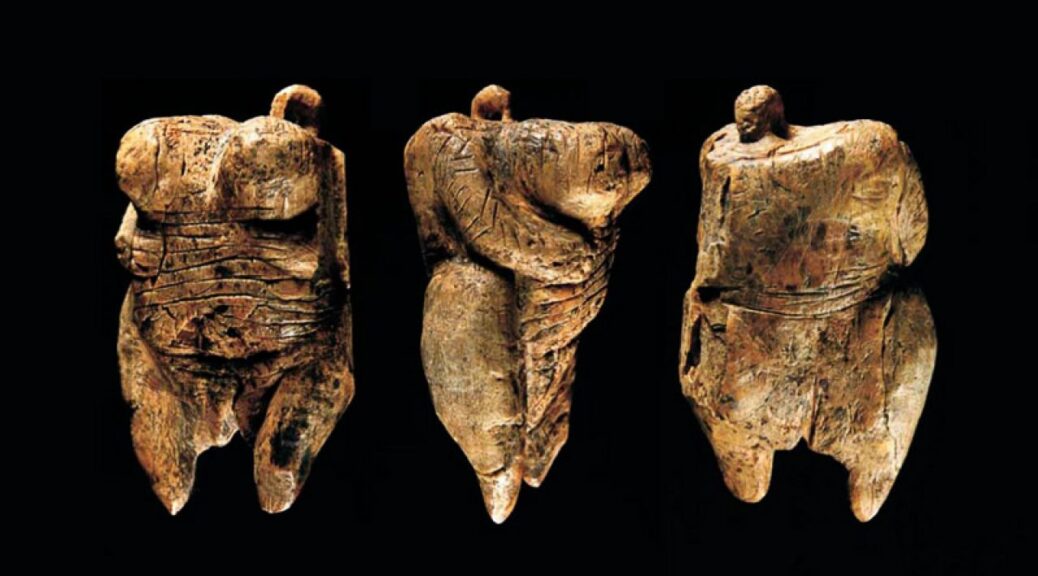The Venus of Hohle Fels is the oldest statue depicting a woman’s figure
The Venus of Hohle Fels is 2.4 inches in height and was carved from the tusk of a woolly mammoth tusk. It has been pieced together from six fragments found in a cluster, about 10 feet below ground, although the left arm and shoulder are still missing. It has a short and squat body whose waist is slightly narrower than its broad shoulders and wide hips.

The figurine has no head; in its place, a carved ring protrudes between the shoulders, indicating that the sculpture was probably worn as a pendant or amulet.
The figure is endowed with prominent breasts, while its two short arms with their carefully shaped hands and fingers rest on the upper part of the abdomen.
A number of deeply etched horizontal creases (indicating clothes?) traverse the torso from just below the breasts to the pubic triangle. The buttocks and genitals are portrayed in exaggerated detail, while the legs are small and pointed.
Several of the characteristics of the Venus of Hohle Fels, notably the obese shape, the focus on female attributes (and hands) with a corresponding lack of attention to the head, arms and legs, are reminiscent of other Venus sculptures from the Aurignacian period such as the Venus of Galgenberg (Austria) and the Venus of Monpazier (France), as well as later examples from the Gravettian period (c.22,000-27,000 BCE), including the Venus of Dolni Vestonice (Czech Republic), the Venus of Willendorf (Austria), the Venus of Savignano (Italy), the Venus of Moravany (Slovakia), the Venus of Brassempouy (France), the Venus of Lespugue (France), the limestone bas-relief Venus of Laussel (France), the Venus of Kostenky (Voronezh, Russia), the Venus of Gagarino (Lipetsk, Russia), the Avdeevo Venuses (Kursk, Russia) the Mal’ta Venuses (Siberia), the Zaraysk Venuses (Moscow oblast, Russia) and the Magdalenian Venus of Eliseevichi (14,000 BCE), from Bryansk, Russia.
Discovery and Dating
The Venus of Hohle Fels was discovered in the cave of “Hohle Fels” (German for “hollow rock”) near Schelklingen, by a team of archaeologists from the University of Tubingen led by Professor Nicholas Conard, as reported in the prestigious journal Nature.
The six fragments were found in the cave hall, roughly 10 feet below ground about 65 feet from the cave entrance. They were lying, well preserved, in a layer of red-brown, clay silt below five Aurignacian horizons (radiocarbon-dated to the period 30-40,000 BCE), with about twelve stratigraphically intact anthropogenic features.
The latter’s thickness (2-4 feet) indicates that Venus was created at the beginning of the Aurignacian era, roughly 35-40,000 BCE, and refutes claims that figurative representations only appeared in the later phases of the Swabian Aurignacian (c.33,000 BCE). (Note: all of the 20+ previous finds in Swabia had been of animal or therianthropic imagery – human figures were entirely unknown.)
Curiously, neither the Hohle Fels cave nor the other Swabian caves of Hohlenstein-Stadel and Vogelherd, have yielded any significant cave art, such as paintings or engravings.
In effect the discovery of the Venus of Hohle Fels pushes back the date of the oldest prehistoric carving by at least 2,000 and perhaps as many as 7,000 years – that is, from 33,000 BCE to 35-40,000 BCE). According to Professor Nicholas J. Conard, the find “radically changes our views of the earliest Paleolithic art.”
The good condition of the fragments and the fact they were lying within inches of each other, suggests that the Venus suffered little if any disturbance during its time in the ground.
A few feet away, the team also discovered a flute carved out of a vulture bone, dating back to 34,000 BCE – which makes it the oldest known musical instrument – along with bones (or ivories) belonging to reindeer, horses, bears, mammoths, and ibexes.
To see how the Schelklingen Venus fits into the evolution of petroglyphs and other rock art during the Upper Paleolithic Era of prehistory, see: Prehistoric Art Timeline.
Interpretation
As in the case of later Venus figurines, the figure’s exaggerated reproductive attributes suggest that it may have been a fertility symbol.

Whatever the precise meaning or interpretation of the Schelklingen Venus, the immensely time-consuming work that went into it, using only primitive tools, suggests that this piece of primitive art had a particularly high value in the eyes of the sculptor(s) who carved it.
The Venus of Hohle Fels may not look like a sophisticated example of Paleolithic plastic art, but appearances in this case are misleading. All paleoanthropologists and archaeologists agree that the carving of a human figure – indeed any pictorial depiction (engraving, painting or otherwise) of the human form – represents a major step forward in the cultural development of mankind.
